
Quercus montana, the chestnut oak, is a species of oak in the white oak group, Quercus sect. Quercus. It is native to the eastern United States, where it is one of the most important ridgetop trees from southern Maine southwest to central Mississippi, with an outlying northwestern population in southern Michigan. It is also sometimes called rock oak because of its presence in montane and other rocky habitats.

Carpinus caroliniana, the American hornbeam, is a small hardwood understory tree in the genus Carpinus. American hornbeam is also known as blue-beech, ironwood, musclewood and muscle beech. It is native to eastern North America, from Minnesota and southern Ontario east to Maine, and south to eastern Texas and northern Florida. It also grows in Canada. It occurs naturally in shaded areas with moist soil, particularly near the banks of streams or rivers, and is often a natural constituent understory species of the riverine and maritime forests of eastern temperate North America.
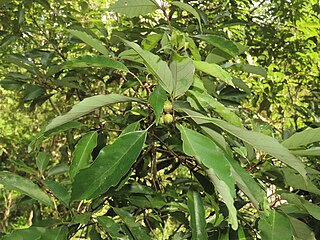
Quercus glauca, commonly called ring-cupped oak or Japanese blue oak, is a tree in the beech family (Fagaceae). It is native to eastern and southern Asia, where it is found in Afghanistan, Bhutan, China, northern and eastern India, southern Japan, Kashmir, Korea, Myanmar, Nepal, and Vietnam. It is placed in subgenus Cerris, section Cyclobalanopsis.

Quercus imbricaria, the shingle oak, is a deciduous tree in the red oak group of oaks. It is native primarily to the Midwestern and Upper South regions of North America.

Quercus dentata, also called Japanese emperor oak, daimyo oak, or Korean oak, is a species of oak native to East Asia. The name of the tree is often translated as "sweet oak" in English to distinguish it from Western varieties. It is placed in section Quercus.
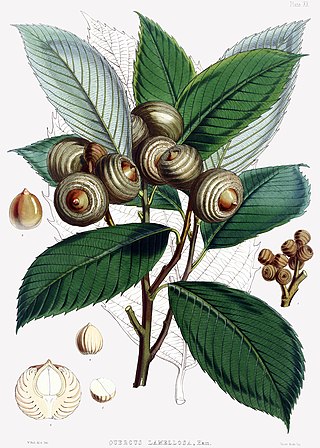
Quercus lamellosa is a species of oak (Quercus) native to the Himalaya and adjoining mountains from Tibet and Nepal east as far as Guangxi and northern Thailand, growing at altitudes of 1300–2500 m. The Lepcha of Sikkim call it book koong. It is placed in subgenus Cerris, section Cyclobalanopsis.

Ostrya virginiana, the American hophornbeam, is a species of Ostrya native to eastern North America, from Nova Scotia west to southern Manitoba and eastern Wyoming, southeast to northern Florida and southwest to eastern Texas. Populations from Mexico and Central America are also regarded as the same species, although some authors prefer to separate them as a distinct species, Ostrya guatemalensis. Other names include eastern hophornbeam, hardhack, ironwood, and leverwood.

Quercus peninsularis, common name peninsular oak, is a species of oak endemic to Baja California, Mexico. It is a shrub or small tree to 10 m, occurring in mountain valleys and canyons up to 3000 m. It is placed in section Lobatae. Leaves are 5–8 cm, flat, leathery and hairy, with pointed tips and 2–5 pairs of teeth. Flowers occur in 3 cm catkins. Fruits are 1.5 cm acorns, stemless, ovoid, with hairy cupules, maturing in a year. Mature bark is reddish; young twigs are thin and hairy.

Quercus alnifolia, commonly known as the golden oak, is an evergreen oak species of Cyprus. Its common English name refers to the golden coloured lower surface of its leaves. Quercus alnifolia belongs to the endemic flora of the island and it is confined to the igneous geological complex of the Troodos Mountains. In February 2006, the parliament of Cyprus selected the golden oak to be the country's national tree.

Crinum asiaticum, commonly known as poison bulb, giant crinum lily, grand crinum lily, or spider lily, is a plant species widely planted in many warmer regions as an ornamental. It is a bulb-forming perennial producing an umbel of large, showy flowers that are prized by gardeners. However, all parts of the plant are poisonous if ingested. Some reports indicate exposure to the sap may cause skin irritation.
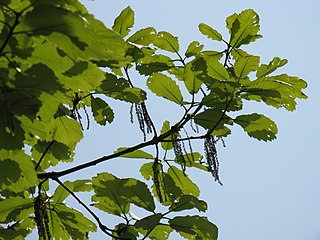
Quercus aliena, the galcham oak or oriental white oak, is a species of oak in the family Fagaceae, in the white oak section Quercus.

Quercus acuta, the Japanese evergreen oak, is an oak native to Japan, South Korea, Taiwan, and China's Guizhou Province and Guangdong Province. It is placed in subgenus Cerris, section Cyclobalanopsis.
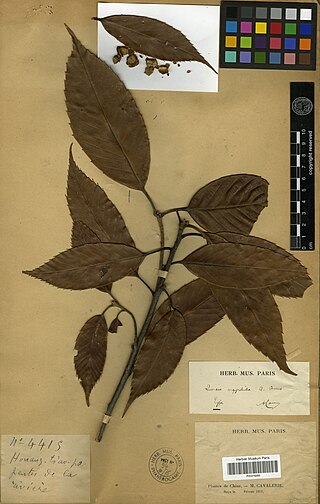
Quercus argyrotricha is a rare Chinese species of trees in the beech family. It has been found only in Guizhou Province in southern China. The common name is Chinese for this species is gui zhou qing gang.
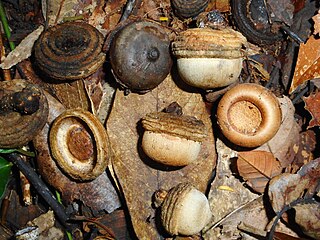
Quercus kerrii is an uncommon Asian species of tree in the family Fagaceae. It is native to Thailand and Vietnam. There are also populations in southern China that according to some authors belong to Q. kerrii but considered by others to belong to a different species, Q. helferiana.Quercus kerrii is placed in subgenus Cerris, section Cyclobalanopsis. Its Chinese name is mao ye qing gang.

Quercus longinux is an uncommon Asian species of trees in the beech family Fagaceae. It has only been found in Taiwan. It is placed in subgenus Cerris, section Cyclobalanopsis.

Quercus schottkyana is an Asian species of tree in the beech family Fagaceae. It has been found in southwestern China. It is placed in subgenus Cerris, section Cyclobalanopsis.
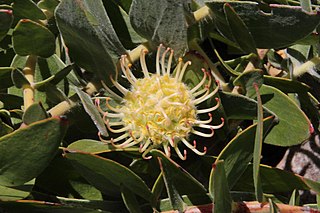
Leucospermum cordatum is an evergreen, creeping shrublet of about 20 cm (8 in) high from the family Proteaceae. It has pale cream flower heads, from which pink flushed styles emerge, the whole reminiscent of a pincushion. Its common name is heart-leaf pincushion in English. It flowers between July and December but the peak of the flowering period is from September to November. It is an endemic species, that is only known from two locations close to each other in the Western Cape province of South Africa.
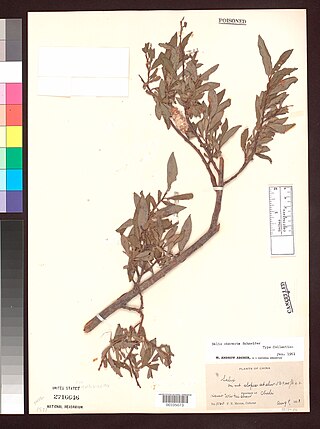
Salix characta is a shrub from the genus of willow (Salix) with initially downy hairy branches. The leaf blades have lengths of 3.5 to sometimes 7 centimeters. The natural range of the species is in China.
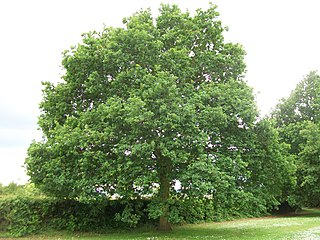
Quercus subgenus Quercus is one of the two subgenera into which the genus Quercus was divided in a 2017 classification. It contains about 190 species divided among five sections. It may be called the New World clade or the high-latitude clade; most species are native to the Americas, the others being found in Eurasia and northernmost North Africa.

Quercus subgenus Cerris is one of the two subgenera into which the genus Quercus was divided in a 2017 classification. It contains about 140 species divided among three sections. It may be called the Old World clade or the mid-latitude clade; all species are native to Eurasia and North Africa.





















